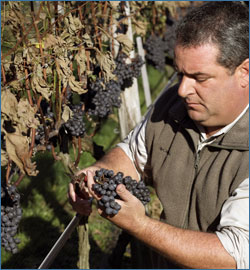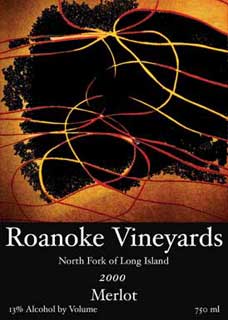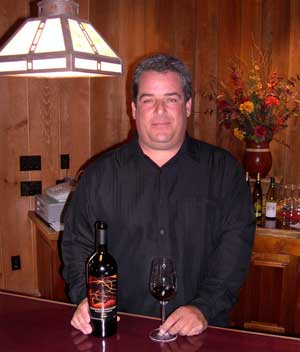

Richard Pisacano is busy on both forks of Long Island as vineyard manager for the Hamptons' Wolffer Estate and the co-owner of Roanoke Vineyards on the North Fork.
North Fork of Long Island (AVA)
Roanoke Vineyards – Producing Cab
That Ricochets Around the Room
As odd as it may sound, I am not convinced terroir exists. I think to say that it does exist would suggest that there is somewhat of a specific regional flavor, characteristic or personality that could not be masked, changed or evolved at the will of the vintner.
~Richard Pisacano
by
Lenn Thompson
February 6, 2007
Rich Pisacano (RP): What kept my interest was the excitement of the boom. I was working for Mudd Vineyards in the late 70’s and everyone was coming to us to learn. We were soon consulting for, planting and maintaining most of the first wave of growers, including Pindar Vineyards, Palmer Vineyards, Island Vineyards (now Pellegrini Vineyards). Cutchogue Vineyards (later Gristina) and Jamesport Vineyards to name a few. Their was a tremendous amount of optimism and energy which we all shared and I was enjoying being part of it.
LT: You started growing grapes back in high school. How did you find yourself falling into the local wine region, which was still in its infancy?
RP: What kept my interest was the excitement of the boom. I was working for Mudd Vineyards in the late 70’s and everyone was coming to us to learn. We were soon consulting for, planting and maintaining most of the first wave of growers, including Pindar Vineyards, Palmer Vineyards, Island Vineyards (now Pellegrini Vineyards). Cutchogue Vineyards (later Gristina) and Jamesport Vineyards to name a few. There was a tremendous amount of optimism and energy which we all shared and I was enjoying being part of it.
Also, my passion was plant propagation and we began grafting grapevines, so the combination of the hype and plant propagation was the hook.
LT: Back then, were grapes treated much like other local crops? Was there any real expertise/knowledge?
RP: The vines were treated according to what vineyard knowledge was available at the time. We were applying the expertise coming from UC Davis in California and Cornell research station in Geneva, New York. We combined the two into our own hybrid which was adequate but certainly not entirely suitable for our region.
LT: So what have growers learned since then? How have they improved?
RP: Most importantly, growers have learned the negative impact that mistakes make on the finished product and how not to repeat them. As growers and vineyards have matured, so has our way of thinking, in terms of how we care for the vineyards. Since the early 1990’s, many growers have become to realize that the vineyard is part of a complex system which we just happen to be harvesting grapes from. Introducing sustainable practices has become more of a responsibility than a choice.
 Prior to that, the mentality, though conventional for the time, was mostly to react to the vineyard. When weeds would grow, kill them or plow them under; if disease or pests were present, spray; when vines would grow, hedge them when it was dry, water them and so on. By realizing that the vines are part of this system and having a higher tolerance to the pressures, most growers have learned to help nurture the system and become much better overall stewards. I often say that you cannot bring the vineyard back into its natural habitat, but you can do your best to invite more of nature back into the vineyard. This is the area which has been most improved on Long Island and will make for a healthier future and better wines, besides being fun and rewarding.
Prior to that, the mentality, though conventional for the time, was mostly to react to the vineyard. When weeds would grow, kill them or plow them under; if disease or pests were present, spray; when vines would grow, hedge them when it was dry, water them and so on. By realizing that the vines are part of this system and having a higher tolerance to the pressures, most growers have learned to help nurture the system and become much better overall stewards. I often say that you cannot bring the vineyard back into its natural habitat, but you can do your best to invite more of nature back into the vineyard. This is the area which has been most improved on Long Island and will make for a healthier future and better wines, besides being fun and rewarding.
LT: What are some of the biggest changes in growing techniques since "the old days"?
RP:: The biggest change has been in the finesse or in the attention to detail. Growers learn the brick and mortar long before they learn the art form of winegrowing. Some learn quicker than others and some never really care to learn, partly because of the lack of importance they put on it and also, that it almost always takes more time, money and effort to achieve.
Techniques have changed with respect to achieving vine balance, improving crop and canopy management and all the many little things that seem to not mean much but can have a tremendous impact on the wine. Most of these techniques are done by hand, standing in the vineyard, one vine at a time.
LT: When you joined Wolffer Estate in 1996 and started growing wine on the South Fork, what were some of the Fork-specific challenges you didn't expect? How did you overcome them over time?
RP: I did not know what to expect. I was surprised by the dews which persisted, mostly caused by the lesser winds on the South Fork. I thought that the proximity to the open ocean would certainly mean higher winds but I quickly learned that it is actually much less windy on the South Fork, compared to the North Fork.
Also the slower pace that the soil warmed in spring was an unusual challenge for me. I thought I'd have to respond but found it to have its advantages actually. It merely meant lower spring disease pressure. The two climates are more similar than different. The South Fork has a delay of spring which is countered by a lengthier fall. The suspicion that the South Fork was inferior to the North Fork was quickly overcome by the first signs of ripeness and most memorably by the very first block of Chardonnay which was harvested at over 23 Brix with beautiful acidity and PH and flavors oozing with fine ripeness. This was
 ripeness I had only previously read about, even having, at the time, a twelve year old North Fork Chardonnay vineyard. The other challenge was the drive. Farmers are not meant to commute.
ripeness I had only previously read about, even having, at the time, a twelve year old North Fork Chardonnay vineyard. The other challenge was the drive. Farmers are not meant to commute.
LT: When you visit other wine regions, what strikes you as the biggest differences between growing quality grapes on Long Island versus other areas?
RP: With the exception of the maritime climate of Bordeaux, France, I find the difference to be in the human factor, where in the Medoc, we absolutely must intervene in the vineyard and steer the direction which the climate is taking the fruit. Most regions rely more on the climate than we do and that is where we differ from most of the world’s regions. I think that in maritime climates like Long Island and Bordeaux, the wine is the symbiotic magic between man, the soil, vine and sea, where in the more arid climates, man plays an important but lesser role in the finished wine. This is why many of us often use the Bordeaux comparison. It is not in an effort to compete or compare our wines as much as it is to learn from and - sorry but - yes, even emulate a great region that has so many similar traits.
LT: You bought Roanoke Vineyards in 2000. What were your goals at the outset?
RP: The goal was to create something special with what was the remaining footprint of one of the truly great North Fork farms, known as Young’s Farms. I saw it as a diamond in the rough. I said that I would plant the vineyards and lay the foundation fo















